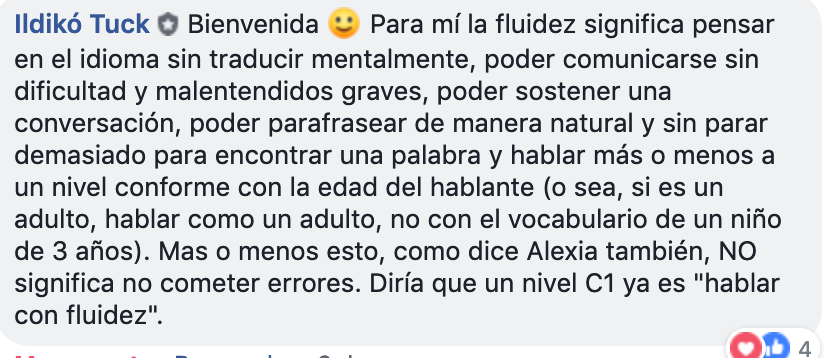FLUIDEZ EN ESPAÑOL

What does it mean to be fluent in Spanish?
First, we want to explain the concept of fluency in any language. For what? To better understand the question above and be able to give a concise answer. So how can we define fluency?
– Speak a language perfectly?
– Be indistinguishable from native speakers?
– Do not make any mistakes when speaking?
– Being able to talk about any issue without impediments?
– Not having an accent?
Not quite. Fluency does not mean perfection , neither in the use of words nor in pronunciation. This concept is not synonymous with precision , although in a way, it is necessary to be understood by others.
Fluency refers to the ability to talk clearly and effectively. It refers to the ability to speak and understand a language enough not to hinder communication. Therefore, fluency means being able to use the language easily and skillfully, with hardly any interruptions . It is expressing your thoughts in a more automated, fast and spontaneous way, despite continuing to make some mistakes.
In Spanish – or in any other language – you don’t have to understand everything or speak perfectly, but you need to let things flow . This means that if there is a word you don’t know, you may be able to explain it with other words in Spanish. Therefore, we can say that fluency in Spanish is the ability to express yourself in the language without even thinking about the steps to follow to allow the conversation to develop.
A good vocabulary base , a good listening comprehension and a good knowledge of grammar are indicators that we talk to a person who is fluent. It could be said then that fluency corresponds to levels B2-C1-C2 in the Common European Framework of Languages.
Considering that fluency is a spectrum – not an end state – we also believe that there are different degrees of fluency, such as conversational fluency or advanced fluency, as we detail below:
Conversational fluency vs. Advanced fluency
In any language, both concepts refer to the language domain spectrum . However, conversational fluency is considered a lower level than fluency (advanced).
– Conversational fluency in Spanish
One acquires conversational fluency when one is able to follow basic conversations with a native speaker. By basic conversation we mean talking about things around you, such as hobbies, weather, tastes, food or other topics of your day to day.
If we know about 2000-3000 words in Spanish, along with basic structures, we will be able to carry out day-to-day conversations with native speakers with reasonable accuracy. We estimate an average of 300-480 hours of study needed (input + output) to achieve conversational fluency from completely initial and initial levels.
We must consider that it is necessary to go through a level of conversational fluency to reach the level of total fluency in Spanish. This means that we must make the discomfort with the language become comfortable – and not only that – discomfort will be necessary as a tool to reach the next level.
Don’t get stuck looking for perfectionism . Aspiring for fluency in conversation is just one step on the path to advanced fluency and then to the higher domain.
– Advanced fluency in Spanish
To speak fluently is to be able to use the language naturally without thinking too much about what you want to say or how to say it. Normally, fluency is accompanied by the correct use of the tongue, but with a margin of error of 5% -10%. However, these errors do not interfere with the understanding of the speech. Even we natives make some mistakes while we talk, but that doesn’t mean we don’t speak fluently.
Having total fluency in Spanish means overcoming the point of stagnation of the intermediate level. Fluency literally means “flow,” as when you have entire conversations with comfort and ease similar to those of a native speaker in various social settings.
As we mentioned before, fluency itself is a spectrum, therefore, different students will need more or less level depending on their interests and the type of conversations they have. We estimate a range between 400-560 hours to reach this level of fluency, starting from an intermediate level of Spanish.
On the other hand, although fluency usually refers to oral communication, today there are different types of synchronous communications (such as WhatsApp, Messenger, WeChat, Skype, etc.). On these platforms, the way to communicate is faster and similar to oral communication. Therefore, in our opinion as teachers, mastering synchronous writing is also part of communicative fluency.
Other opinions
On the other hand, we have asked about the concept of fluency in one of our favorite intermediate and advanced Spanish Facebook groups . And these have been some of the best answers to the question What does fluency mean to you?





In conclusion, we would like to emphasize that achieving advanced fluency in Spanish is a difficult process, but not impossible. It requires months or years of conversational practice with native speakers. However, having fluency in Spanish is more attainable if you are persistent and disciplined with your method.
Finally, we want to share a very representative and funny image of what we have just explained:

Need a little more help to get to MT.FLUENCY ? In the next post we explain ” How to get fluent in Spanish” with 7 specific techniques and some resources. Come on, there are no excuses!
In addition, by clicking on this link you can see the English version of this same post.
YOU CAN DO IT!



